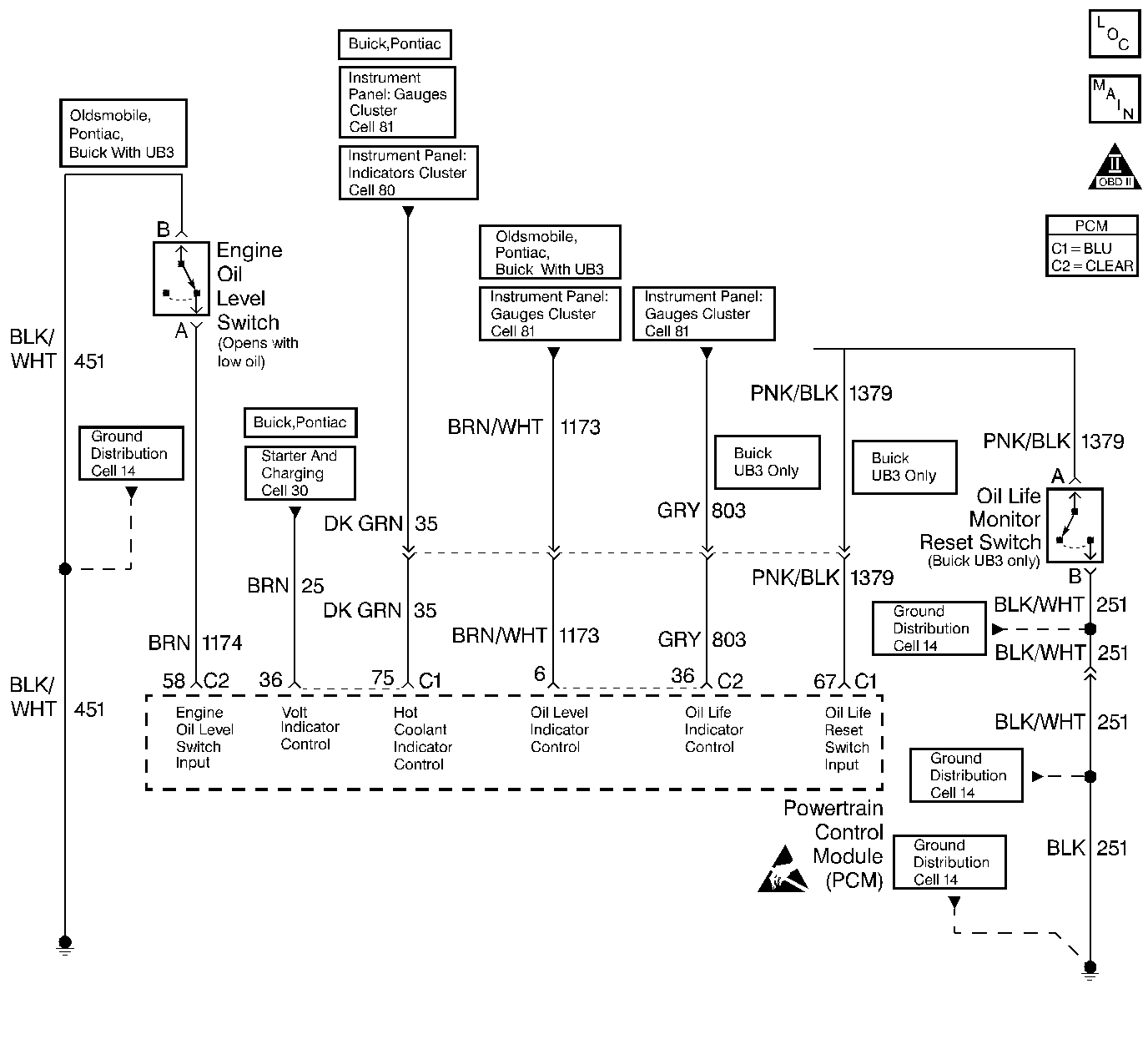
Circuit Description
The PCM controlled lamps are powered through the instrument panel battery positive voltage or ignition positive voltage circuit. The PCM turns ON the bulb, LED, or driver info center indicator by supplying a path to ground through the PCM.
Diagnostic Aids
A PCM controlled lamp ON at all times most likely indicates that a condition is present which requires the attention of the vehicle operator.
Low Oil Level Lamp - will be illuminated for about a minute after the ignition has been turned ON when the PCM tests for low oil level and the engine oil level switch indicates that a low oil level condition exists. The PCM determines whether or not to test for low oil level based on the difference between engine coolant temperature at the last shutdown and engine coolant temperature at startup. This is to ensure that the oil has drained back into the sump before testing. When the ignition is first turned ON, the PCM commands the Low Oil Level lamp ON for a brief period of time to test the bulb.
Check for the following conditions:
| • | Poor connection at PCM. Inspect harness connectors for backed out terminals, improper mating, broken locks, improperly formed or damaged terminals, and poor terminal to wire connection. |
| • | Damaged harness. Inspect the wiring harness for damage. If the harness appears to be OK, disconnect the PCM and turn the ignition ON . Observe a voltmeter connected to the affected PCM output circuit while moving connectors and wiring harnesses related to the PCM output circuit. A change in voltage will indicate the location of the fault. |
| • | Engine oil level switch circuit. Refer to Engine Oil Level Sensor and/or Switch Diagnosis . |
Test Description
Numbers below refer to the step numbers on the Diagnostic Chart.
-
Normally, ignition feed voltage should be present on the output control circuit with the PCM disconnected and the ignition turned ON.
-
Checks for a shorted component or a short to B+ on the output control circuit. Either condition would result in a measured current of over 500 milliamps. Also checks for a component that is going open while being operated, resulting in a measured current of 0 milliamps.
-
Checks for a short to voltage on the lamp control circuit.
-
This vehicle is equipped with a PCM which utilizes an Electrically Erasable Programmable Read Only Memory (EEPROM). When the PCM is being replaced, the new PCM must be programmed.
Step | Action | Values | Yes | No |
|---|---|---|---|---|
1 | Was the Powertrain On-Board Diagnostic (OBD) System Check performed? | -- | ||
2 | Was the Instrument Cluster System Check performed? | -- | Go to Diagnostic System Check - Instrument Cluster in Instrument Panel, Gauges and Console. | |
Is voltage near the specified value? | B+ | |||
Does the current reading remain between the specified values? | 0.05 -0.5 Amp (50-500 mA) | |||
Is voltage at the specified value? | 0V | |||
6 | Locate and repair the short to voltage in the affected PCM output circuit. Refer to Wiring Repairs . Is action complete? | -- | -- | |
7 | Check the ignition feed fuse for the instrument panel cluster indicator lamps. Is the fuse blown? | -- | ||
8 |
Is action complete? | -- | -- | |
9 |
Is voltage near the specified value? | B+ | ||
10 |
Was a problem found? | -- | ||
11 |
Was a problem found? | -- | ||
12 |
Does the test lamp flash ON and OFF? | -- | Go to Diagnostic Aids | |
13 |
Was a problem found? | -- | ||
14 | Locate and repair open in the ignition feed circuit to the instrument panel cluster indicator lamps. Refer to Wiring Repairs . Is action complete? | -- | -- | |
15 | Replace the instrument panel cluster. Refer to one of the following procedures in Instrument Panel, Gages and Console: Is action complete? | -- | -- | |
|
Important: Replacement PCM must be programmed. Refer to Powertrain Control Module Replacement/Programming . Replace the PCM. Is action complete? | -- | -- | ||
17 | Operate the affected lamp using the scan tool output tests function. Does the affected lamp operate properly? | -- | System OK |
